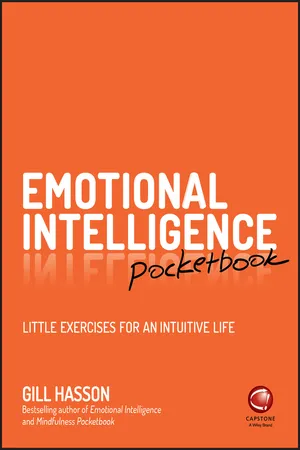
- English
- ePUB (mobile friendly)
- Available on iOS & Android
About This Book
A practical "how-to" guide to changing the way you think about your emotions
Bestselling personal development author Gill Hasson is back with this pocket sized guide to dealing with your emotions. Learn how to understand yourself and those around you with practical tips and tricks that will help you be more assertive, forge stronger relationships and manage anxiety.
Did you know that the way you approach your own thoughts and feelings determines your happiness and success in every area of your life? Just think about it for a second, it's not necessarily the smartest people that are the most successful or the most fulfilled in life, being clever or highly skilled isn't enough. Your ability to manage your feelings, other people and your interactions with them are what makes all the difference.
This highly practical book is full of advice, tips and techniques to help you:
- Understand and manage your emotions
- Become more assertive and confident
- Develop your social skills and your interactions with others
- Handle difficult situations, events and other people
The Emotional Intelligence Pocketbook is your practical "how-to" guide for understanding yourself and those around you.
Frequently asked questions
Information
PART 1
UNDERSTANDING EMOTIONS
KNOWING WHY WE HAVE EMOTIONS
Everyone knows what an emotion is until asked to give a definition. Then it seems, nobody knows. – B. Fehr and J. Russell
In Practice
Nothing vivifies and nothing kills like the emotions. – Joseph Roux
- Think of situations when an emotion prompted you to do or say something automatically, without thinking. Where you acted instantly, for example, out of fear, disgust or anger, you responded without thinking.
- Think of times when you’ve experienced a social emotion; an emotion that has prompted you to do or say something to manage the interactions between you and someone else.
- Think of a time when someone else has shown you empathy, compassion or kindness. Did it help you to feel understood, comforted or supported?
- What about the times others’ emotions have influenced you? Perhaps you’ve noticed that someone was frustrated and upset and it prompted you to offer them your help.
UNDERSTANDING THE ASPECTS OF EMOTIONS
Emotions bridge thought, feeling, and action.– John D. Mayer
In Practice
Let’s not forget that the little emotions are the great captains of our lives and we obey them without realising it.– Vincent Van Gogh
- Situation: Giving a presentation at work
- Emotion: Anxiety
- Physical feelings:
- Thoughts:
- Behaviour:
- Situation: Passing a test, exam or receiving a job offer
- Emotion: Joy
- Physical feelings:
- Thoughts:
- Behaviour:
- Situation: An event you were looking forward to being cancelled
- Emotion: Disappointment
- Physical feelings:
- Thoughts:
- Behaviour:
UNDERSTANDING THE POSITIVE INTENT OF EMOTIONS
Never apologize for showing your feelings. When you do, you are apologizing for the truth. – José N. Harris
In Practice
Your intellect may be confused, but your emotions will never lie to you. – Roger Ebert
Table of contents
- Cover
- Title page
- Copyright
- INTRODUCTION
- PART 1 UNDERSTANDING EMOTIONS
- PART 2 MANAGING EMOTIONS
- PART 3 DEVELOPING YOUR EMOTIONAL INTELLIGENCE
- PART 4 DEVELOPING YOUR SOCIAL INTELLIGENCE
- ABOUT THE AUTHOR
- MORE QUOTES
- USEFUL WEBSITES
- EULA